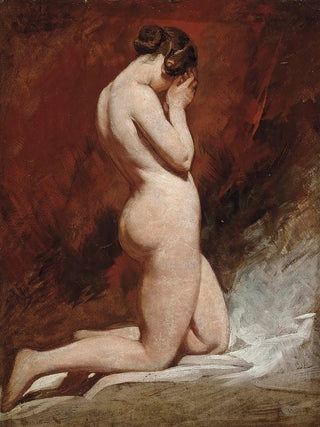Art print | Nude kneeling - William Etty


View from behind

Frame (optional)
"Nu à genoux" by William Etty stands as an iconic masterpiece of British Romanticism, captivating art enthusiasts with its sensuality and emotional depth. This painting, created in the early 19th century, embodies a bold exploration of human beauty while fitting into an artistic context marked by aesthetic and cultural upheavals. The viewer's gaze is immediately drawn to the delicate posture and subtle rendering of forms, inviting attentive contemplation. Through this work, Etty succeeds in transcending mere bodily representation to offer a reflection on vulnerability and the power of the human being.
Style and uniqueness of the work
William Etty's style is distinguished by his unique approach to the art of the nude. Unlike his contemporaries who often favored idealized depictions, Etty chooses to present a realistic and human vision of his subjects. In "Nu à genoux," light plays a predominant role, highlighting the curves and shadows of the female body while creating an intimate atmosphere. The rich and nuanced color palette evokes deep emotions, enhancing the visual impact of the art print. The composition, both dynamic and harmonious, demonstrates the artist's technical mastery, capable of capturing beauty in its most authentic form. This work is not merely a simple representation; it becomes a true dialogue between the artist, the subject, and the viewer, inviting each to question the nature of the body and beauty.
The artist and his influence
William Etty, born in 1787 in York, is a significant figure in the history of British art. His career, marked by successes and controversies, reflects the tensions between academic tradition and the innovative aspirations of his time. Etty, who studied at the Royal Academy of Arts, was influenced by old masters while seeking to renew the pictorial language of his era. His work paved the way for a new appreciation of the art print in the nude, inspiring generations of artists to explore the representation of the human body with increased sensitivity.

Matte finish

View from behind

Frame (optional)
"Nu à genoux" by William Etty stands as an iconic masterpiece of British Romanticism, captivating art enthusiasts with its sensuality and emotional depth. This painting, created in the early 19th century, embodies a bold exploration of human beauty while fitting into an artistic context marked by aesthetic and cultural upheavals. The viewer's gaze is immediately drawn to the delicate posture and subtle rendering of forms, inviting attentive contemplation. Through this work, Etty succeeds in transcending mere bodily representation to offer a reflection on vulnerability and the power of the human being.
Style and uniqueness of the work
William Etty's style is distinguished by his unique approach to the art of the nude. Unlike his contemporaries who often favored idealized depictions, Etty chooses to present a realistic and human vision of his subjects. In "Nu à genoux," light plays a predominant role, highlighting the curves and shadows of the female body while creating an intimate atmosphere. The rich and nuanced color palette evokes deep emotions, enhancing the visual impact of the art print. The composition, both dynamic and harmonious, demonstrates the artist's technical mastery, capable of capturing beauty in its most authentic form. This work is not merely a simple representation; it becomes a true dialogue between the artist, the subject, and the viewer, inviting each to question the nature of the body and beauty.
The artist and his influence
William Etty, born in 1787 in York, is a significant figure in the history of British art. His career, marked by successes and controversies, reflects the tensions between academic tradition and the innovative aspirations of his time. Etty, who studied at the Royal Academy of Arts, was influenced by old masters while seeking to renew the pictorial language of his era. His work paved the way for a new appreciation of the art print in the nude, inspiring generations of artists to explore the representation of the human body with increased sensitivity.






